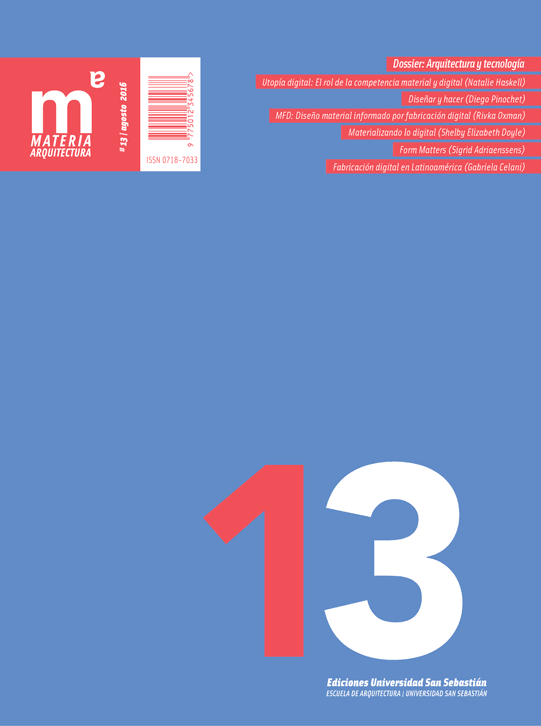Digital Utopia: The Role of Materially and Digital Competency
Barra lateral del artículo
Palabras clave:
Contenido principal del artículo
Resumen
Digital technologies allow for an unprecedented level of design experimentation and construction possibilities. The article presents the argument that digital technologies and fabrication support a re-connection to materials and materiality, whilst facilitating the exploration of utopian ideals within a design context. Recent exemplars in the fields of architecture and academia that embrace a materials-first approach to innovative projects made possible by digital technologies and digital fabrication are discussed.
Detalles del artículo
Materia Arquitectura proporciona acceso inmediato y gratuito a todos los contenidos de esta edición electrónica, publicada simultáneamente con la edición impresa. Materia Arquitectura no cobra honorarios a los autores por ningún concepto.
Todos los contenidos de esta edición electrónica se distribuyen bajo licencia Creative Commons de “Atribución-Copartirigual 4.0 Internacional” (CC-BY-SA).
La licencia Creative Commons permite el acceso libre e inmediato al contenido y permite que cualquier usuario lea, descargue, copie, distribuya, imprima, busque o genere enlaces a los textos completos de los artículos, permitiendo también que estos puedan ser rastreados para indexarlos, pasarlos como datos a software o usarlos para cualquier otro propósito legal. Asimismo, la licencia otorga derechos de uso a quienes a su vez utilicen una licencia abierta (Creative Commons o equivalente).
Los derechos de los textos y las imágenes publicadas pertenecen a sus autores, quienes otorgan a Materia Arquitectura la licencia para su uso. La gestión de los permisos y la autorización de publicación de las imágenes (o de cualquier material) que contenga derechos de autor y sus consecuentes derechos de reproducción en esta publicación es de exclusiva responsabilidad de los autores de los artículos.
Toda vez que mencionen su origen, los autores son libres de distribuir sus artículos por otros medios. Cualquier reproducción total o parcial del material deberá citar su procedencia.
Descargas
Citas
www.archdaily.com/199442/gc-prostho-museum-research-center-kengo-kuma-associates
BROWNELL, B. E. (2011). Matter in the Floating World: Conversations with Leading Japanese Architects and Designers. New York, NY, USA: Princeton Architectural Press.
FARMER, G., & STACEY, M. (2012). In the making: Pedagogies from MARS. Architectural Research Quarterly, 16(4), 301-312.
FUAD-LUKE, A. (2009). Design Activism: Beautiful Strangeness for a Sustainable World. Sterling, VA, USA: Earthscan.
LOSCHKE, S. (2014). Crafting relations: Aspects of materiality and interactivity in exhibition environments. Craft + Design Enquiry(4), 89-107.
MENGES, A. (2012). Material Computation: Higher Integration in Morphogenetic Design. Architectural Design, 82(2), 14-21.
MENGES, A., & REICHERT, S. (2012). Material capacity: Embedded responsiveness. Architectural Design, 82(2), 52-59.
OXMAN, N. (2010). Structuring materiality. Architectural Design, 80(4), 78-85.
OXMAN, N. (2015). Templating design for biology and biology for design. Architectural Design, 85(5), 100-107.
OXMAN, N., ORITZ, C., GRAMAZIO, F., & KOHLER, M. (2015). Editorial. Computer-Aided Design, 60, 1–2.
PINDER, D. (2015). Reconstituting the Possible: Lefebvre, Utopia and the Urban Question. International Journal of Urban and Regional Research, 39(1), 28-45.
SHEEREN, O. (2015, September). Ole Sheeren: Why great architecture should tell a story (Ted Talk). Retrieved from www.ted.com:
https://www.ted.com/talks/ole_scheeren_why_great_architecture_should_tell_a_story?language=en
Artículos más leídos del mismo autor/a
- Natalie Haskell, Utopía digital: El rol de la competencia material y digital , Materia Arquitectura: Núm. 13 (2016): Materia Arquitectura 13 (Agosto/August 2016)
